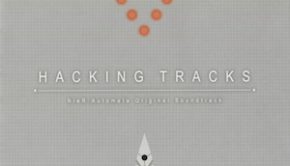Tim Wright (aka CoLD SToRAGE) Interview: From Lemmings to Wipeout
Tim Wright is regarded as one of the most talented and influential game composers in the United Kingdom. A veteran of Psygnosis and Sony Computer Entertainment Liverpool, he was behind the music of many Amiga favourites, including Lemmings and Beast 2. Under the name CoLD SToRAGE, he also created technologically commanded CD-based soundtracks such as Wipeout and Colony Wars. In recent years, he has combined running his own production company Tantrumedia with creating original albums, music software, and electronic remixes.
In an especially indepth interview, Tim Wright reflects on his career so far. He reveals the inside story behind many of his beloved projects, including Wipeout and Lemmings, before going into depth about his recent original album productions. Finally, he provides some details about his upcoming remix album to commemorate Psygnosis’ 25th anniversary. He has kindly supplemented the interview with some particularly interesting photographs related to memorable and landmark moments in his career.
Interview Credits
Interview Subject: Tim Wright
Interviewer: Dave Valentine, Chris Greening
Editor: Chris Greening
Coordination: Dave Valentine, Chris Greening
Interview Content
Dave: Tim Wright, many thanks for talking to us today. You have been active in the games industry for 20 years now. How did you get into computers, games, and music in the first place?
Tim Wright: My earliest recollection of being inspired by computers was probably the computer in the original TV show Star Trek. You could talk to this authoritative disembodied voice and ask it questions about anything. Clearly science fiction, but I thought that was really amazing and hoped for a day when it would be possible.
I also remember as a small child making a computer out of a small OXO box… I would make a long strip of paper, and draw various screens along it, then I’d push two pencils through the box at either end, tape one end of the paper strip to one pencil, wind it up, and tape the end of the strip to the other end. A window cut into the front of the OXO box was the ‘screen’. I’d then lay in bed at night, winding through the screens, imagining it was a small portable computer that would access a massive database of data somewhere. This memory came back to me the other night when I was lying in bed watching the trailer to Iron Man 2 on my Android G1 Phone. My dream had become physical, and it only took a couple of decades to happen.
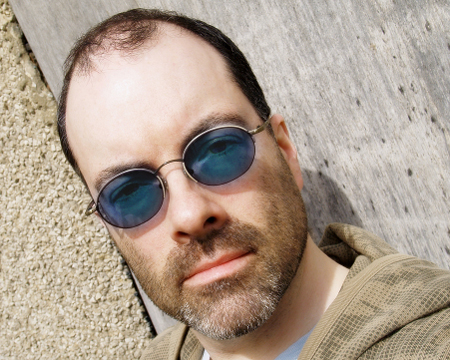
I am one of five children, and four of us are boys. So there was quite a male influence in the house in terms of what toys were purchased. We had a pong (bat’n’ball) game — Grandstand 2000 I think it was — and then an ATARI VCS 2600. Now the thing that really intrigued me about the VCS wasn’t the games, it was a small catalogue that came in the box. Somewhere in there, they had a “Basic Programming Cartridge” which I desperately wanted to get hold of. But I don’t think my father, or even most of my brothers shared my curiosity, so we never got hold of it. I had some early experience with computers in the form of the Acorn Atom, which we got to use occasionally at school. My friend’s father also had a Commodore PET, which I never got to use, but I thought it must be something quite special.
When the BBC Microcomputers became all the rage in UK schools I saw an avenue into getting a computer at home. My parents agreed it was a good idea, and we ordered one. At the time there were really long manufacturing delays, so to sate my appetite for a computer, my father bought us a Commodore VIC 20 instead. I learned to program in BASIC on the VIC, and this helped me learn that computers were nowhere near the level of the onboard computer in Star Trek, and that it was going to take a lot of hard work to get it to do anything more exciting than print my name down the screen! The VIC 20 was soon traded in for a Commodore 64 and I also got hold of a Casio Programmable Calculator. I spent a lot of time immersed in coding, playing games and listening to the wonders of the SID Chip being skilfully handled by the likes of Rob Hubbard, Ben Daglish, Martin Galway and other amazing C64 musicians.
While all this was going on, I was taking Piano Forte lessons between the ages of 7 and 16. I managed to get to Grade 5 before I decided I’d really had enough of classical instruction and wanted to create my own music more than play other people’s. In my teens, computers were starting to become a large part of writing the sort of music I was interested in. The likes of Howard Jones, Nik Kershaw, Kraftwerk and J.M. Jarre all used computers and I wanted to do likewise. The C64 was one way of doing this at a beginner level, but I never really managed to start getting truly creative until I bought my first Amiga A500 with a Bank loan funded by my job as programmer for Littlewoods in Liverpool back in 1989.
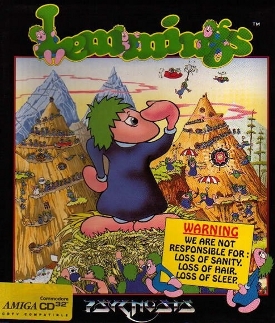 Dave: Lemmings was the first soundtrack that I was exposed to as a kid. Little did I know it was composed by someone also in the Wirral! What inspired your quirky approach to this soundtrack and, in particular, your decision to adapt famous tunes?
Dave: Lemmings was the first soundtrack that I was exposed to as a kid. Little did I know it was composed by someone also in the Wirral! What inspired your quirky approach to this soundtrack and, in particular, your decision to adapt famous tunes?
Tim Wright: Brian Johnston was in charge of creating the music for Lemmings in the first instance. He’d been told to come up with 3 channel music using very little RAM. I’m not sure if he’d been told to write covers of famous tunes or not, but when a Lemmings ‘work in progress’ demo arrived at Psygnosis, they discovered many of the tracks were copyrighted, and had been taken from T.V. and films like Batman and so on. I received a telephone call from Ian Hetherington (then M.D. of Psygnosis) asking if I could very quickly compose some tunes to replace these problematic tracks.
I recall chatting with John White (then Director of Software Development) about how I could do some covers of famous tunes, but ones that were out of copyright, such as folk tunes and so on to which he agreed. I created several unique tunes, some covers of Psygnosis game tunes (at their request) and covers of what I thought were very old folk tunes.
Several years after the release of Lemmings, Psygnosis received a letter from the copyright holder of “Oh Little Town of Bethlehem” asking for royalties on the millions of copies of games that had been sold. They paid them a few thousand pounds as I recall. Ian Hetherington joked that the money would come out of my next music job. Thankfully he was joking and was good natured about the whole thing. Ironically, the copyright on this tune ran out a few years later.
Dave: Your music for the Shadow of the Beast series is also very famous. How did you expand on the approach from David Whittaker’s soundtrack for the two sequels?
Tim Wright: After being asked to write the score for Beast 2, I listened to David’s work on the originalShadow of the Beast as a yardstick of ‘I have to do this well and more’ which felt like a daunting proposal. David was one of my all time music heroes, so to be stepping into his shoes was both thrilling and terrifying.
Martin Edmondson from Reflections was very hands-on when it came to the music. He had strong ideas about what the music should sound like… even down to which samples he would like to hear included from a KORG M1 Synthesizer. Luckily, I had a close friend who had that exact synth, so we set to work sampling Martin’s sounds, along with others that I thought might work well. The style was pretty much indicated by the original Shadow of the Beast, but I wanted to expand upon that and make it darker and more like a film score than the previous game.
Another friend, Steve Nuttall who I’d worked with at Littlewoods, was a pretty talented guitarist, and I wanted some electric solo guitar in a couple of the pieces: the title theme, and the game over theme. The title theme was cobbled together from around an hours worth of guitar playing as an original piece, whereas the game over music was copied from a cassette tape that Martin had sent me, with the instructions “copy this…”. Many years later, it emerged that the game over tune I’d copied was a small section from one episode of Miami Vice! Oddly enough, this small piece was also written by a guy called Tim.
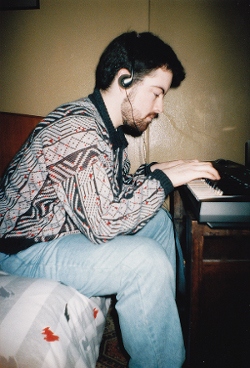 Beast 3 was written in quite a rush, and at the time I recall feeling it wasn’t some of my best work, and that I preferred what I’d done on Beast 2. Now the years have passed, I’m not so sure if that’s the case, and I can see that I did actually create some complex works in Beast 3 and perhaps I was just feeling overly self critical at the time due to the deadline pressures.
Beast 3 was written in quite a rush, and at the time I recall feeling it wasn’t some of my best work, and that I preferred what I’d done on Beast 2. Now the years have passed, I’m not so sure if that’s the case, and I can see that I did actually create some complex works in Beast 3 and perhaps I was just feeling overly self critical at the time due to the deadline pressures.
Dave: Relatively little of your Amiga music has been released on CD. Do you find this regrettable?
Tim Wright: Funny you should ask, since I am at this very moment working on a new album that will consist of re-worked Amiga tracks from my early Psygnosis days. Until the end of May 2010, people can visit this page and listen to over 70 Amiga tracks written for 1990’s Psygnosis games and vote on which ones they’d like to see featured on the album.
Aside from this, there have been some releases, most notably my contributions to the Amiga Immortal series of CDs developed by Jan Zottmann. I’ve contributed to Volumes 2, 3, and the soon to be released Volume 4. The album series is actually quite good fun… just one or two tracks every couple of years is a nice way of dipping my musical feet back into my collection and dusting it down for consumption in the here and now.Immortal 4 will feature a song from Lemmings, which I’ve entitled “March of the Green Tops”.
I’ve also sneaked in some of my Amiga tracks into my album releases. I won’t divulge where, but anyone who has listened to MELT and Android Child may have spotted some of my Amiga themes in there.
There have also been some unofficial CD compilations where people have simply recorded the MOD files as WAV and burned them to CD. I guess I should really have taken action against them, but they were such low volumes. Suing someone who is essentially doing it in their back bedroom would probably be a fruitless undertaking. Not that I condone it, but you have to be sensible about these things.
Dave: The original Wipeout became popular for its high quality electronic soundtrack. How would describe your approach to this soundtrack? Would you describe this style the default style you like to work with?
Tim Wright: Definitely not. Well, not at the time that’s for sure. My default style back then was heavily 80’s electro-pop influenced — the kind of music that is currently back in vogue in the UK. I was also into classical too. So, as you can see I was by no means the ideal choice for the Wipeout project!
Creating the music for Wipeout was as much a learning curve as it was a challenge. I was largely led by the development team members, and guided as to where I should be looking for inspiration. I went to night clubs and listened to hours of music in the style they thought would fit.
My first creations were a blend of ambient, industrial and pop. Not really suited to the game. I remember Nick Burcombe, the designer, being really kind in his criticism and suggested I just keep at it.
It was around this time that the whole of Psygnosis left the Liverpool docks in favour of the new Wavertree building — all very futuristic, with green glass, steel and wire. I had a professional studio built, and I think this gave me extra drive to take myself more seriously as a composer. Not long after we’d moved in, I did a marathon session of writing. Fuelled by Red Bull, Pizza and long summer evenings I composed all the music for Wipeout within two to three weeks, only leaving the studio to go home for a quick wash and change of clothes (my wife at the time was pretty understanding… well, my now ex-wife of over 12 years passed, so maybe it did take it’s toll?).
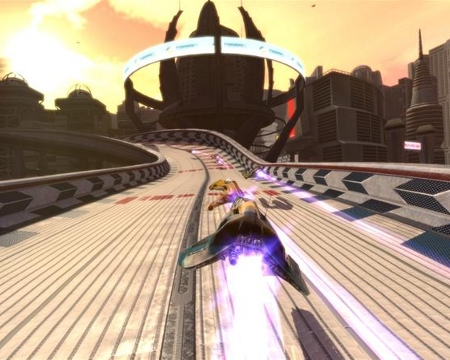
The end results surprised me as much as the development team and my co-worker Mike Clarke. The music wasn’t quite what I’d been listening to, but one of the artists said it was just the right amount of ‘now’ with some ‘future’ thrown in.
Dave: Wipeout was also one of the first games to feature CD quality audio. What were the technological challenges? Was it a refreshing change from the more technologically limited soundtracks of the Amiga?
Tim Wright: Prior to Wipeout I’d created CD Audio for Sensible Soccer and No Escape on Mega CD, as well as Krazy Ivan for PSOne. As a result, it wasn’t my first foray into CD Audio for games, but it certainly was a challenge to convert.
Mike Clarke and I went from having studios that contained professional music gear that we had to compress down to fit into Amiga MOD files, into needing to use the gear to it’s fullest. Moreover we had to buy in equipment and software to allow us to compete with larger studios and professional musicians who had several years head start on us. The best way to learn was to actually ‘do it’. Trial and error made us better, and we made some great choices and some bad ones. Bars and Pipes on the Amiga was one of Mike’s most inspired recommendations — we both used Amiga A1200 machines to drive all our MIDI equipment.
Was it more fun writing CD Audio than Amiga audio? It was certainly a fresh challenge. Around the time CD Audio in games was coming in, I think I was reaching my peak in terms of what I could achieve on the Amiga. I’d toyed with Octamed and 16 bit sample playback, but the Amiga gaming format was dying off, and the other platforms we still composed MOD files for only supported the 4 channel 8bit mods. Having said all this, I’m composing MOD file music for DSi games right now. So it’s still a skill that comes in handy, even in 2010!
Dave: Later instalments in the Wipeout series became dominated by licensed music. What are your thoughts about this trend? What are the advantages and disadvantages of incorporating licensed music to games?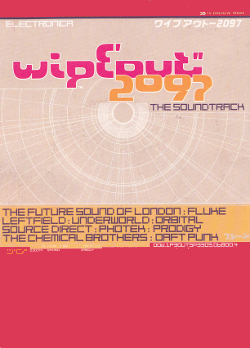
Tim Wright: Licensed music can be more expensive to secure than developing original material. It can be less rewarding to the player, because they may already own the tracks featured in the game, so they’re effectively paying for something twice. Also, many games allow the user to replace the in-game tracks with MP3s of their own choosing, so it’s becoming less and less relevant to include well known music.
I think the average gamer would prefer to have something new to listen to… something that has been written specifically for the game. There are exceptions to the rule, where a well known track really suits as title music, or maybe as background music in a scene, in which case I think it’s a great idea.
There are advantages in using licensed music. Cross promotion, whereby the owner of the music agrees to add some weight in terms of P.R. within music circles. They can also release the soundtrack of the game as a CD/MP3 release. From the developer’s perspective, they’re getting music that is already composed and recognised by some of the general public, which can sometimes help in selling the concept from a subliminal perspective.
Dave: More recently, you’ve worked extensively on the eJay series on behalf of your general production company Tantrumedia. Could you elaborate on your involvement in this series and, in particular, how you approached their music in an interactive manner?
Tim Wright: My involvement in creating music sequencing software began with the formation of Jester Interactive. My brother and I set up Jester with his then boss to create a music creation package for PSOne. This was unique in terms of it being the first utility based product on the PlayStation, and also the first real console based music writing package. My roles on this project were Project Manager, Designer, Musician, Tester and Evangelist in terms of P.R. and Sales. This left me very little free time over the 9 months of development! As the company grew, I moved up to a Creative Director role.
After MUSIC 3000, Jester’s direction changed. It had grown into a much larger company developing racing games and working on role playing games, while the music software took a back seat. My brother and I decided to leave to work on other things. We formed Checkmate Solutions Ltd. to develop personal information management software.
Due to complications in gaining government funding, we fell back on our music software skills and agreed to develop eJay projects for Empire Interactive. We developed a new engine from the ground upwards. It was originally intended to be on PC and Xbox, so we developed it to work on both. Sadly, it was decided to stick to PC and forget about Xbox. Again we were a small team working on a tight deadline, so I acted as Project Manager, Musician and Designer. Thankfully, Empire took care of P.R. and Sales, so it wasn’t quite as stressful as the early days of Jester.
The style of music and samples I created for Dance 7 and HipHop 6 was largely driven by what eJay had done before and my own personal take on these styles. As with everything, you can’t please all the people all the time, so we had just as many keen fans as we did people who liked the software but who weren’t keen on the samples. I still really like the real-time synthesizers we created in these packages, and I occasionally use them now, to create unique sounds or loops.
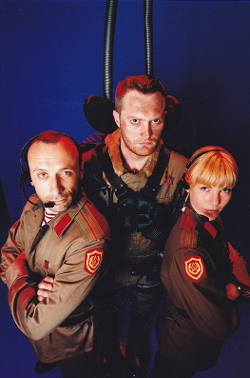 Dave: In addition to the aforementioned works, you have composed for numerous other games for the Amiga, Sega CD, and PlayStation. If you were to name three other scores that were highlights for you, what would they be and why?
Dave: In addition to the aforementioned works, you have composed for numerous other games for the Amiga, Sega CD, and PlayStation. If you were to name three other scores that were highlights for you, what would they be and why?
Tim Wright: On Amiga I’d say Magician’s Castle. This game was sadly canned, but I think it saw the light of day as a PC title on a magazine CD covermount many years later. Mike Clarke confided that he thought it was some of my best Amiga work, which was high praise from him.
On Mega CD, I’d probably say Sensible Soccer. Even though these were MOD files and we only had 64Kb for samples, I managed to squeeze out some pretty convincing music in a number of styles.
On PlayStation I’d be tempted to say Krazy Ivan. Never before or since have I composed in this style. It’s a kind of grungey ambient techno. Most of these tracks were driven from samples of short wave radio and snippets taken from Sci-Fi films — I won’t incriminate myself by saying which ones.
I realise I’ve not specified actual tracks in my replies above, but if you listen to the music from these projects, feel free to choose your own favourites!
Dave: Since 2005, you have composed a string of original albums and singles. How does composing for such media compare with creating game scores? Do you find it a more enjoyable creative process?
Tim Wright: MELT was my first album. Come to think of it now, I don’t know why it was called MELT? I know I had some fast paced songs, and some more mellow tracks. I decided I should divide them into two CDs and call one Blue and one Red… a kind of ‘hot and cold’ affair. Maybe that’s where the name came from?
This first album mainly came into being because I’d received a lot of fan mail asking where people could get albums by CoLD SToRAGE. So one day I thought I should gather together all my unused music, along with new compositions, and create a proper album. Originally it was going to be on CD, but I decided to get on board with trends at the time for on-line downloads. MELT was almost like a bit of house keeping with a cherry on top. Hence there’s a lot of diversity in that album.
Since then I’ve released Android Child, CoLD SToRAGE HD, Project Moonbounce 2009 and Tik Tak in terms of non-game albums. Creating these albums was pretty organic. It wasn’t like I sat down and forcibly created them. Each one came into being either because of a drive from someone else, or and idea that I felt just had to be developed further. Each had a seed that gave me ideas to work on, so in that respect I guess the seed was in place of a game concept.
In summary, I find writing music enjoyable. Once I’m ‘in the groove’ I forget that I’m writing for an album, or a game or a TV advert. I just enjoy creating the music, with an eye on where I’m going with it.
Dave: You developed your versatility further on ANDROID CHILD and CoLD SToRAGE HD. What were the concepts behind each of these albums? Are you proud of each of these accomplishments?
Tim Wright: I am proud, but I hope I’m humble about it. You won’t hear me telling people my music is wonderful and the best thing since sliced bread, but I do think it’s got value and I will encourage people to take a listen.
Following MELT, Android Child was a very personal and introspective work. Someone called it my ‘sophomore’ album. Not sure if they just meant my second album, or that I was a wise fool! During the writing of this album my father-in-law died. He was great guy and a real friend, so one of the tracks was written while he was really ill and I dedicated the album to him too. At one time it was really difficult to listen to this album, especially that one track, but now I can listen and get something out of it. I think music takes you to places, and re-kindles very personal memories. My albums do that for me, and the e-mails I’ve had from fans tell me that my music does that them too.
CoLD SToRAGE HD was approached as a game project rather than a stand-alone album. I put myself in the frame of mind I would be in if I had been tasked with working on the project. The goal was to give my fans a fresh CoLD SToRAGE experience whilst playing Wipeout HD.
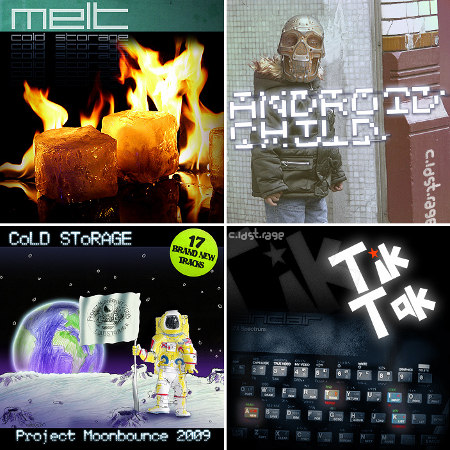
Dave: In the last year, you have also released Project Moonbounce and TikTak. Could you elaborate on your approach to these albums? What are your favourite tracks among them?
Tim Wright: Project Moonbounce 2009 came into being from a fleeting thought as I went to sleep one night. The idea of bouncing music off the moon grew over the following days, and I started to get in touch with people who had the skills and equipment to make it happen. I’m very grateful to Howard Ling (G4CCH) without whom it would not have been possible, and also the people who run the satellite installation at Dwingeloo.
Coincidentally it turned out that 2009 was International Moonbounce Year AND the 40th Anniversary of the Apollo 11 moon landing! I knew nothing of this when I came up with the concept, something people raise an eyebrow at. At first I was gutted, because I thought my project would be swallowed up by all the other activity, and I would be seen as an also-ran. But at the end of the day, I think it was a happy coincidence, and hopefully a fitting tribute to astronauts and skilful radio amateurs around the World. It was also great to have my son contribute to the project in the form of the cover artwork, something he is immensely proud of!
TikTak came about because I found tracks I’d composed using Techno eJay 5 some years back. Instead of just listening to them and filing them away, I decided to re-master them and release them in a short-form album. I didn’t really expect a massive response to it, but I was pleasantly surprised by how many people really loved the tracks. The name TikTak just came into my head. I did a quick Google, and it appears there was a band called TikTak many years ago, but they are no longer together, so I stuck with the name. The artwork almost happened by itself too. I took a photo of my Spectrum computer, and highlighted the letters T,I,K,A making all the others monochrome. I think more people commented on their love of 8-bit computers than the music when the album first launched (laughs)!
Dave: These albums have been popular among game music listeners, but are perhaps less well known in the mainstream industry. What do you think of this? In general, do you think being known as a games musician is a help or hindrance in terms of being taken seriously in mainstream music?
Tim Wright: That’s true. But then those are my roots, and I’m immensely grateful for the exposure I’ve had from games. I can pretty much go to anywhere in the world and, if people ask who I am, I can say “Oh, I wrote the music for Lemmings and Wipeout“. More often than not, people will have played or know of one or both. Some will know me from the MUSIC / MTV Music Generator products, or maybe from the eJay products. Most musicians find it hard to gain a global audience, but I’ve happily managed to generate a fanbase in Europe, the Americas, Asia and Australasia, and at least I’m not stuck for a familiar topic of conversation with strangers.

On the one hand I’m always excited to get new fans and introduce people to my music, but on the other hand it’s nice to be below the threshold of inclusion in trashy magazines alongside famous musicians. That’s not to say I haven’t had coverage on television, in newspapers, and in specialist press, and I like to keep the clippings and recordings so that maybe I can show them to my grandchildren in the future.
Being known as a games musician was almost laughable back in the 80’s and 90’s. Only the core gamers appreciated chip music back then. Nowadays, having that kind of heritage can give you kudos in many eyes, and there is a fond love of chip based music, some of which has been included in chart music recently by Timbaland and so on.
I think one way I could improve my profile would be to start doing live appearances. It’s something I’ve done years ago, but not recently. I do find the idea exciting and frightening in equal measure, but I think I’ll end up doing something over the next year or so. I get a lot of requests, so it’s time to get on stage!
Dave: On that note, do you feel that the style of music you’re most well known for games tends to fence you when it comes to trying new styles? Do you think your often daring deviations in the aforementioned albums tended to pay off?
Tim Wright: In general you have to appreciate that in terms of fan base, you will have people who like you for you. These dedicated followers will happily join you down your road of discovery, and try what you have to offer. They may not love everything, but they won’t desert you and are along for the ride.
Then there are fans who like you for one style. These fans dip in and out of your work when you produce something they can enjoy, and they are rarely keen on listening to anything outside that remit. The latter group are generally pretty vocal about what they like too!
I’m happy with that scenario to be honest. I like constructive criticism. My next album, provisionally entitled PSYGNOSIS 25, will be decided upon by the fans. So hopefully I’ll be pleasing as many people as possible. True enough, they don’t know what styles I’ll employ when I remix these old Amiga tunes, but neither do I at this point! The album won’t be Amiga remixes all in the style of Trance, nor will they be note perfect copies with up-to-date sounds. Each piece will be tackled in it’s own right, and that’s what will make the album diverse and interesting. I hope!
 Dave: Moving on to something very recent, you have also scored Gravity Crash and released an album dedicated to it. What were your musical and visual inspirations while composing for this shooter? What will its album release offer to consumers?
Dave: Moving on to something very recent, you have also scored Gravity Crash and released an album dedicated to it. What were your musical and visual inspirations while composing for this shooter? What will its album release offer to consumers?
Tim Wright: The game is essentially arcade gaming in the 80’s viewed through rose tinted spectacles. So I took the same approach when I composed the music. In-game the tracks are around 3-4 minutes long, and they are engineered to loop forever rather than fade out. For the musical album, I took the pieces apart to varying degrees and extended them all to much longer mixes, added new themes, and produced them more for listening pleasure rather.
So if people have enjoyed hearing the music in the game, they can get a completely fresh experience from the album. I’ve also heard of people buying the album and then buying the game, so it’s a two way street. I also created special mixes for a virtual CD Single, which came out just prior to the actual game which was well received.
Dave: Now looking retrospectively, you have extensively used various instruments, musical equipment, and software synths over your career. Looking back, which are your favourite forces and technology to use? How does your studio look now?
Tim Wright: Looking back, the hardware I’ve had most fun with was a Roland JD800 synth, but the thing I used to greatest effect was an AKAI S2800 sampler. Without my trusty Amiga computers (A500/A1200) none of my MOD music would exist, and the music from Colony Wars, Wipeout, andKrazy Ivan would probably have sounded a lot different. Aside from these, I do have a soft spot for Mackie equipment, I had a 1602 mixer and HR824 speakers.
These days I think most people would be surprised at how little equipment I use. I monitor using ALESIS M1 Mk.2 Active speakers or listen through Sennheiser HD650 headphones. My master keyboard is an AKAI MPK49. All my audio is fed out of an Audio Kontrol 1 and in terms of synthesizers, effects, mixers and so on, they’ve all gone. I am completely software based these days. Partly because it’s more flexible and cleaner, but also because I don’t have to panic if a synth dies. So long as you have your data backed up, you can just get another PC and start writing music again. I use Sonar, Reason, and some of my eJay products to create my music these days.
Dave: During your career, you have engaged in many interesting collaborations. Which people did you especially enjoy working with? For the future, if you could co-write on a game with any composer of your choosing who would you choose to work with?
Tim Wright: In terms of musical composition, it’s been a fairly solitary affair to be honest. In my earlier days I was in a couple of bands and some one-off stage bands, but only very briefly. Writing music on the Amiga was by it’s very nature a one man activity. In moving on to writing CD Audio I never really expanded on that. For a year or two I did write music with a very close friend and a female vocalist, but life took over and although we keep in touch, the music is just sat on a hard drive.
 If I could collaborate with anyone, I’d probably choose people I thought I could learn a lot from. The likes of Vince Clarke, J.M. Jarre, Paul Hartnoll, and Gary Langan. Aside from industry figures, it might be fun to work on a project with another game musician, someone who knows the ropes in terms of writing for games. It might be fun to bounce ideas around again… When Mike Clarke and I worked at Psygnosis, we’d often ask each other what we thought of a track we were writing, and I guess I miss that.
If I could collaborate with anyone, I’d probably choose people I thought I could learn a lot from. The likes of Vince Clarke, J.M. Jarre, Paul Hartnoll, and Gary Langan. Aside from industry figures, it might be fun to work on a project with another game musician, someone who knows the ropes in terms of writing for games. It might be fun to bounce ideas around again… When Mike Clarke and I worked at Psygnosis, we’d often ask each other what we thought of a track we were writing, and I guess I miss that.
Dave: Between producing game scores, creating original albums, managing Tantrumedia, and looking after your family, you must have very little free time. How do you manage to fit in? Do you find it all stressful or do you manage to relax sometimes too?
Tim Wright: I do tend to bring a lot of this on myself to be honest! There are work projects that just have to be done to earn a living; whether they are websites, music projects, software development or printing projects. Many people think I write music all day, but the truth is you have to pay the rent, and as well as the music composition I’m managing projects at Tantrumedia, most of which I’ll have direct input into.
When you run a company it’s far to easy for work and free time to blend seamlessly. So you never really clock out, or as my wife might add, sometimes I never really clock in either (laughs)! Some days I have to try hard to make sure that everyone gets a piece of me, but I don’t always get the proportions right. I guess maybe that’s an unavoidable consequence what I do.
I learned a lot when we were forming Jester Interactive. Working there took up so much of my time that I nearly missed out on my son’s first months completely. So I try a lot harder to have more family time, but I’m sure they’d tell you they’d like more! It can be stressful when there are many projects underway, but you just have to learn to switch off, have a beer and relax, and not think about what needs doing tomorrow or the day after for a few hours.
Dave: Looking back, is there anyone who you think was really pivotal in your successes so far, whether professional or personal?
Tim Wright: I guess everyone thanks their family? My parents and siblings were key in many ways to my successes. My brother Lee coded up playroutines during the Amiga days and developed product in the Jester and the Checkmate days, so he was really pivotal to my success. Shaun Morris, a true friend, has been key in many of my musical adventures, so he really does deserve credit.
Although my piano teacher Mr. Krueger isn’t overly fond of the works I’ve created, as he is firmly planted in the classical era, he was still a massive influence on me. Without Ian Hetherington taking a chance on me I’d not have taken the path I have, and been involved in the specific games I’ve worked on. Who knows when or how I’d have gotten into commercial games if not through Psygnosis?
There are others who have helped in their own unique way, not least of all Claire and Jake and all the other people that I’ve mentioned in this interview or who gave me a nudge in the right direction at some point. All the people I worked with at Jester Interactive were really great, and I’m in touch with most of them from time to time. Steve Pick deserves a mention as he has always been there for me, and he developed the CoLD SToRAGE logo I still use today. Sorry to anyone I’ve not mentioned in person, you know I love you without me saying it in so many words!

Dave: Also, are there any final words you’d like to say to your fans around the world? Many thanks for your time.
Tim Wright: My final words (hopefully not my ‘actual’ final words) are that I’m really grateful to be where I am in my life right now. I’m content with who I am, where I am and what I’m doing. Yes it’s still tough in many respects, but if life was completely perfect I’d stop working. Thankfully I can still see things to do, things to improve upon and I always look forward to the next project.
A massive thank you to all the people who take the time to listen to my music, especially those who throw some money into my coffers for the pleasure! Aside from the PSYGNOSIS 25 album I have other musical projects on the back burner; I’m writing a book and I’m about to release a range of CoLD SToRAGE clothing too… so that’s going to be great fun!
Posted on May 7, 2010 by Dave Valentine. Last modified on May 21, 2014.


